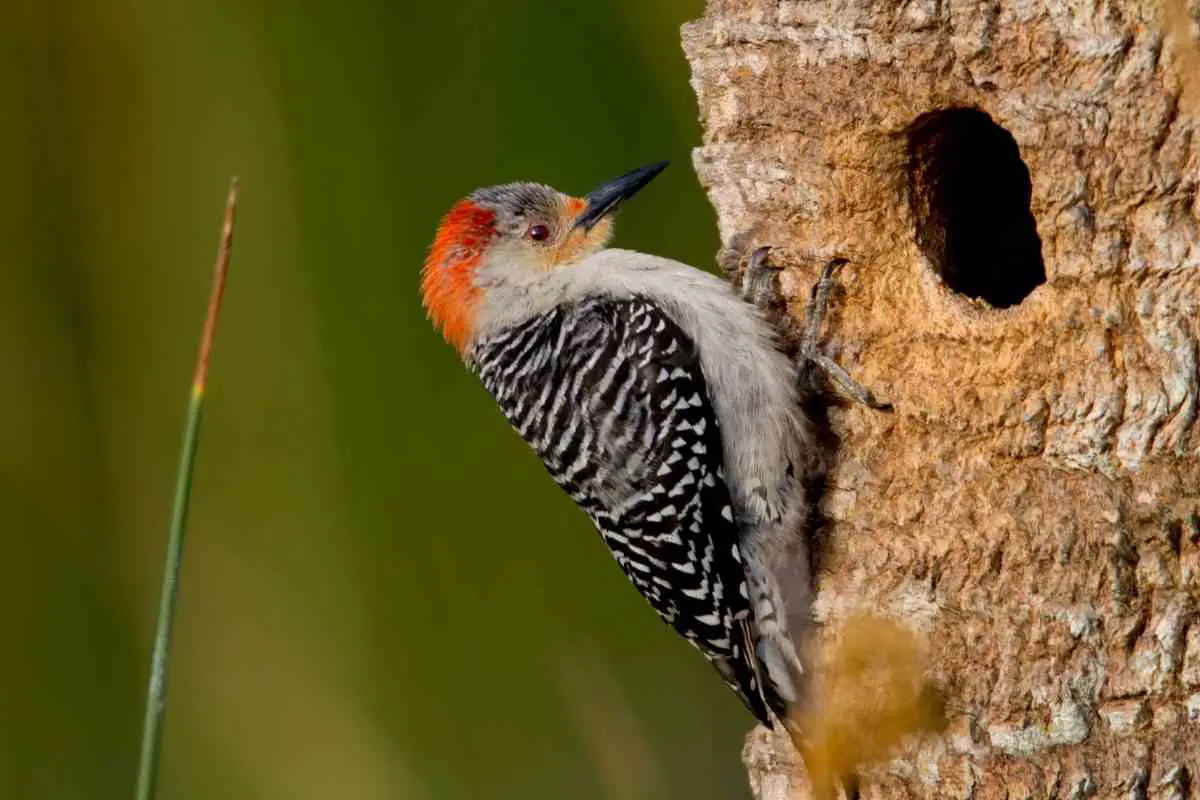Woodpeckers get their name from incessantly pecking on tree trunks, often searching for food.
However, the long, hardened beaks do more than that. These birds use them to dig holes into trees to make nests for living, incubate eggs and raise young ones.
Here are more details about woodpecker nests.
How Woodpeckers Make Nests
Woodpeckers make nests by excavating into tree trunks, a process called excavation.
Both males and females participate in this three-to-six-week project, although the males contribute more.
These nests provide shelter to parents and young ones and are also helpful during the 14-day incubation period.
In Spring – Woodpeckers drill into dead stumps or dying trees to make nests. Although it’s typical of woodpeckers to bore tree trunks while feeding, the cavities are much larger when making nests. Usually, the nests are slightly larger than the birds’ body width.
Woodpeckers are cavity nesters, meaning they make nests instead of invading readymade ones.
They target all tree types, whether rotten or healthy. If rotten, they clean up the bad parts before starting construction.
As mentioned above, both parents help build the nests, but the male does most of the work. He begins by cracking the wood and digging a cavity lasting from 2 to 3 weeks.

The cavity’s diameter ranges between three and six inches, while its depth varies from 8 to 16 inches.
It’s worth noting that woodpeckers don’t source materials outside when building nests. Instead, everything used comes from excavation.
Precisely, the birds use the wood chips and twigs that fall as they dig the cavities into making the nest’s interior. Sometimes, they might use feathers.
Constructions start by winding strands around, followed by shaping the structure using the breasts.
This continues until all strands intertwine to form a bowl. The last step involves laying down feathers to create the nest’s floor.
Many woodpecker species use one nest per breeding season. However, most of them dig several holes before finding an appropriate one.
How Long Does a Woodpecker Take to Dig a Liveable Nest?
Pileated woodpeckers, the largest in the family, take at least three weeks to complete building a nest.
However, when focused, a male can excavate two 6″ inch holes with a significant diameter within two hours.
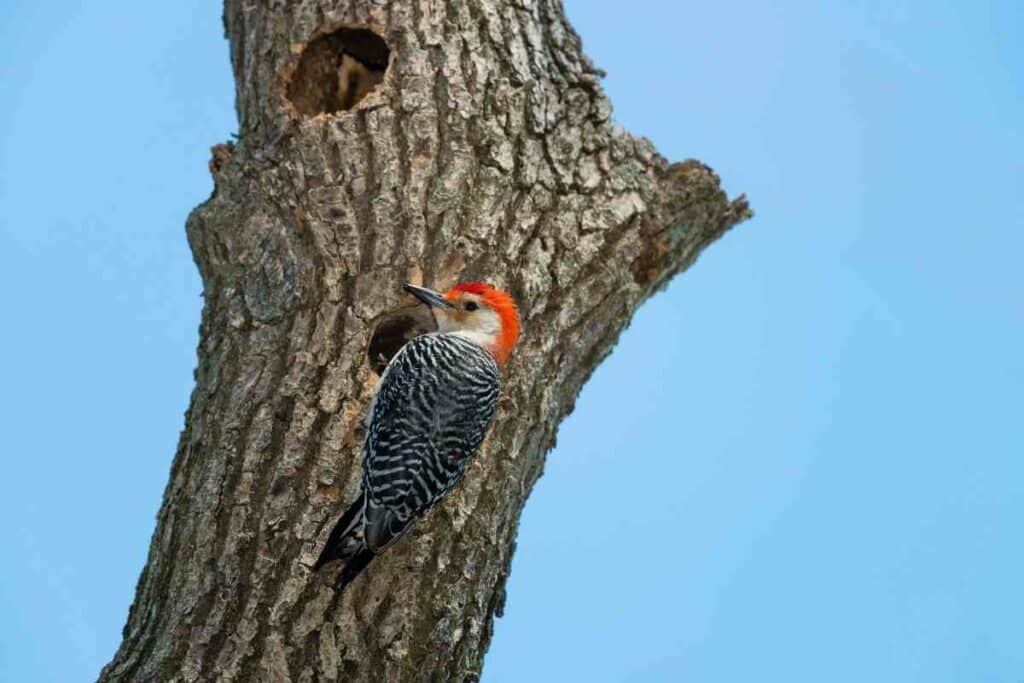
In an ideal situation where the birds wouldn’t have to look for food or defend themselves against other animals, digging and building a nest would take a few hours. However, this isn’t practical.
When excavating holes, digging speed depends on the bird’s size and health and the wood’s softness.
Dying, rotting woods tend to have soft and pliable interiors, making it easier to remove the wood. Conversely, healthy living trees have robust trunks that require more effort to breach.
Did You Know? Woodpeckers apply forces as high as 1400 g when pecking tree trunks. To put this into perspective, a headbutt ranging between 60 and 100 g is enough to cause a concussion.
These birds have adaptive features that allow them to apply such great force. For example, they have specialized beaks, hyoid bones, and skulls that prevent brain injury when pecking.
Where Do Woodpeckers Build Nests?
Woodpeckers build nests in hollowed parts of tree trunks.
These cavities must be deep and wide enough to accommodate the parents, eggs, and growing babies.
The birds build nests by digging holes and chipping away the wood. Sometimes, woodpeckers can opt to live in birdhouses if available.
To attract these birds into your yard, construct a birdhouse and use sunflower seeds or peanut butter as bait.
Do Woodpeckers Reuse Their Nests?
Reusing nests depends on the species.
Most woodpeckers build new nests yearly, as the old ones are too messy and uncomfortable.
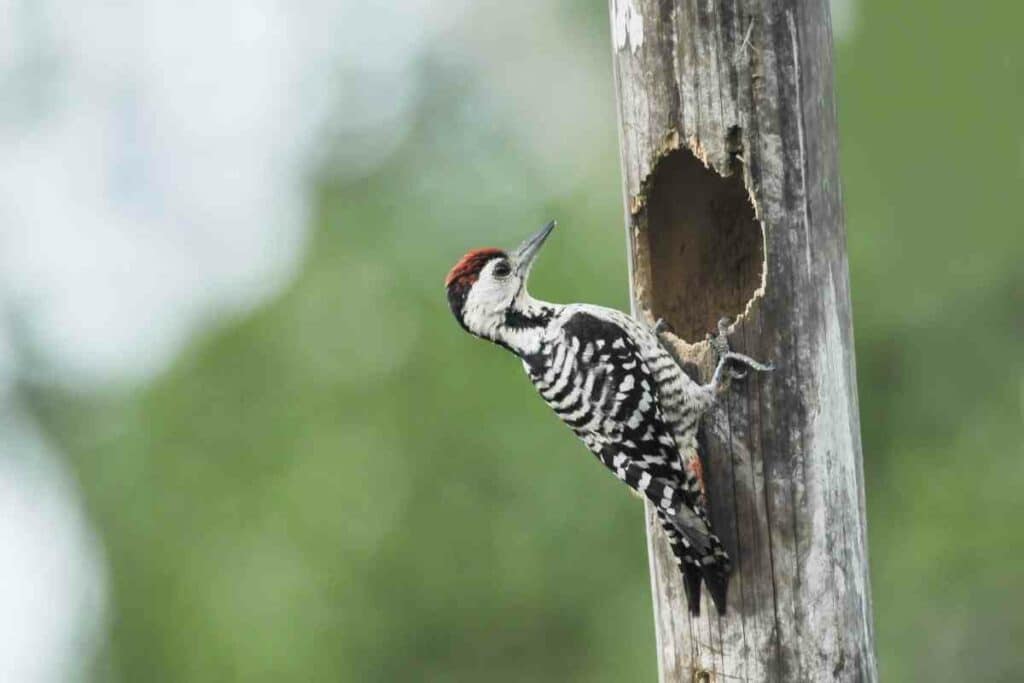
Old nests usually contain eggshell fragments, decomposing food, and fecal matter, which make them filthy and unliveable.
Building a nest is demanding and time-consuming. Digging a tree trunk takes at least 4 weeks and even longer to make the interior suitable for raising babies.
Both male and female parents participate in nest building, but the former contributes more.
Some woodpecker species that construct new nests include downy, hairy, and pileated woodpeckers.
However, not all woodpeckers are hard workers. For some, building a nest isn’t worth the effort.
Species such as acorn and read-headed woodpeckers are known to return to their old nest, clean it, and reuse it for many years before constructing a new one.
Research shows that acorn woodpeckers avoid building new nests to save time and energy. However, many believe this is why some woodpecker species reuse old nests.
How Long Do Baby Woodpeckers Stay in the Nest?
Generally, young woodpeckers stay in the nest for approximately three weeks.
However, this varies with species. Some babies can stay for as long as 1 month before leaving the nest.
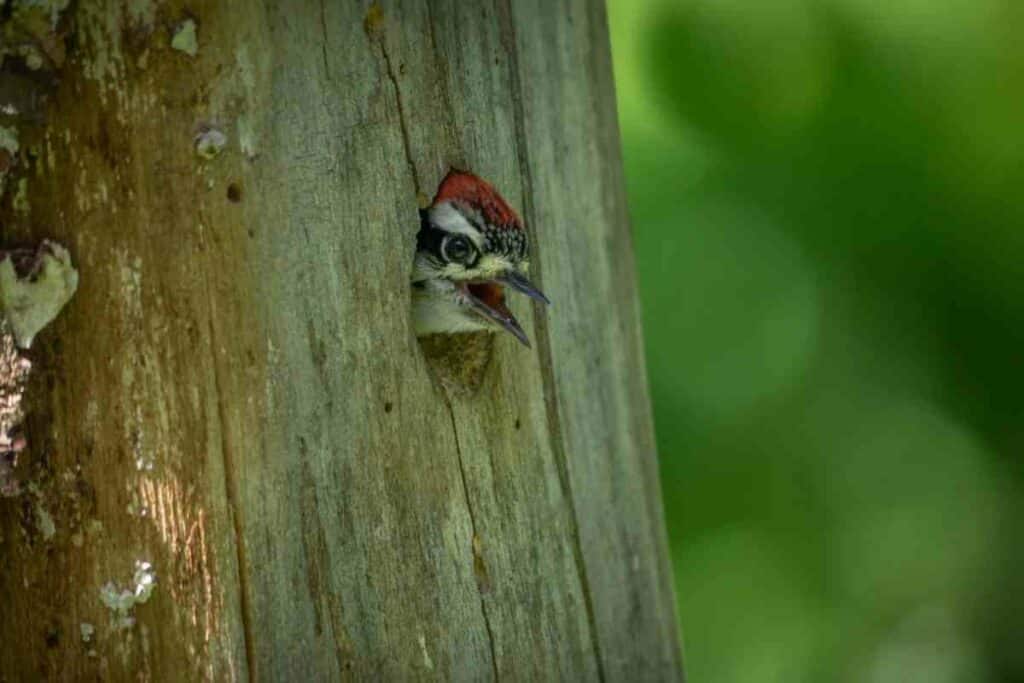
Males and females work together to raise baby woodpeckers. They incubate, brood, and feed the young ones.
After fledging for the first time, the babies remain in the nest for a few weeks as they learn to become independent.
How to Find Woodpecker Nests
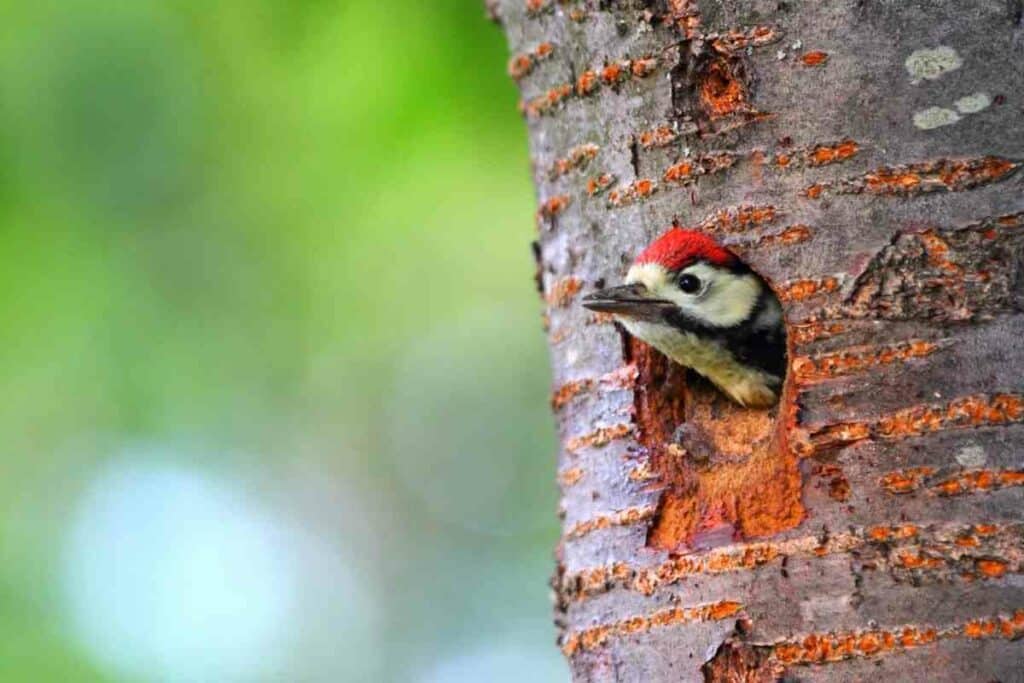
Here are useful tips for finding woodpecker nests:
- Find a likely habitat. Woodpeckers tend to live in places with many trees.
- Once you reach a forested area, reduce your walking pace and listen. If you hear pecking sounds, move closer to see the source. It’s worth noting that water moving in a stream and branches scraping in the wind can sound like a woodpecker.
- If you’re sure it’s a woodpecker, approach the bird if it’s less than 100 yards from you. Otherwise, ignore the sounds because the bird will fly before you reach its position.
- Sometimes, you might notice a woodpecker flying between trees. If this happens, track it with your binoculars as long as it remains in range. Then, it might lead you to its nest.
- Always approach a woodpecker or its potential habitat with the sun behind you. The sun’s light interferes with the bird’s vision so that it can see clearly and escape. However, it doesn’t affect yours.
- If you see a tree trunk with an injury or fungal growth, it’s a potential site for a woodpecker nest. As such, you should use your binoculars to find nest holes. If it’s wide enough to accommodate a woodpecker and looks new, watch it for some time for any activity. Woodpeckers spend a lot of time in nests during the breeding season, so it shouldn’t take more than 20 minutes to see a bird entering or leaving the hole.
- You might see other bird species if you aren’t lucky to spot a woodpecker or its nest. Use your binoculars to zoom in and enjoy your surroundings. You can also discover new plants and flowers during your adventure.
- When searching for woodpecker nests, always look for crawling reptiles, raccoons, porcupines, and even bear cubs. These are potentially harmful. Also, it’s advisable to go searching in the morning. The searches should last more than three hours, as they would be boring.
Why Woodpeckers Nest in Your House
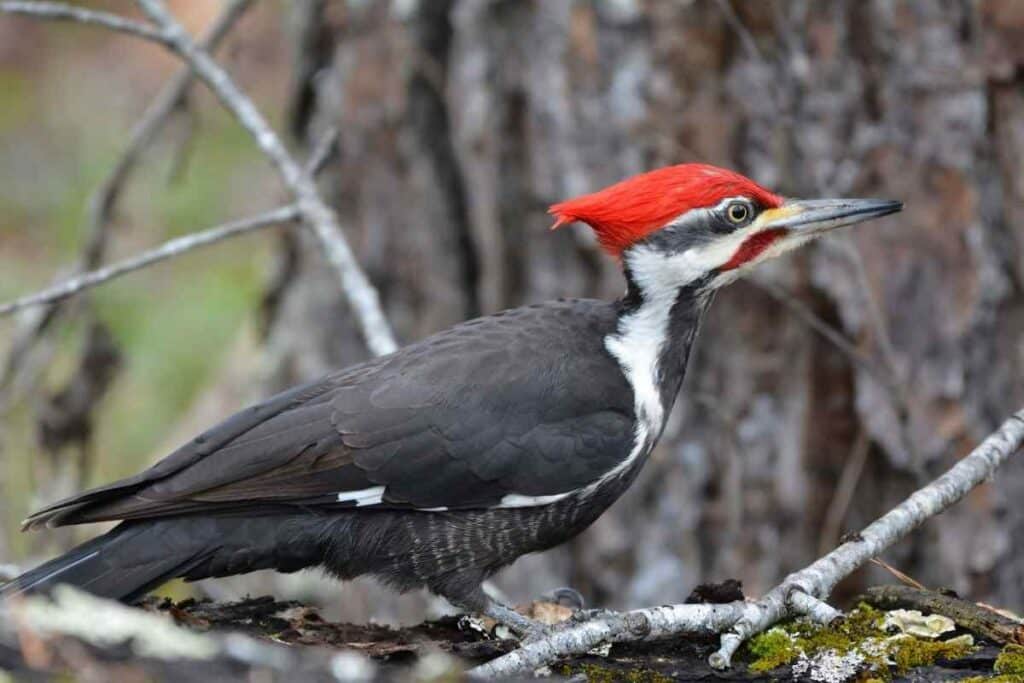
Woodpeckers might nest or start drumming near your house for three main reasons:
- They might be trying to attract a mate. Like humans and other animals, woodpeckers use the best means to attract potential mates. For the birds, making noises and drumming is an effective method of wooing female birds.
- The birds might be looking for a suitable nest site. Remember, these birds nest in spring in time for their breeding season. A woodpecker has immense pecking power, enough to create a large hole in your wooden structure. Once it enters, it can stay for more than a month until the eggs hatch and the fledglings are ready to fly.
- Woodpeckers might be looking for food. It’s easy to assume that the birds are after termites when they continually infest your home. However, they could be looking for other insects, such as ants and flies.
Finally, you can differentiate a nest from a foraging site by checking the holes’ size and patterns.
A single large hole is most likely a nest, while several small ones are a foraging site.
How to Get Rid of Woodpecker Nests

Woodpeckers are a protected species, making it illegal to disturb their nests.
Therefore, the best way of dealing with them is prevention.
Here are proven ways of preventing woodpeckers from targeting your home.
Wrapping Up
Woodpecker nests beautify your yard, and their inhabitants, woodpeckers, help deal with insects.
However, they can be destructive, especially if your yard has wooden structures. They also make irritant noises.
